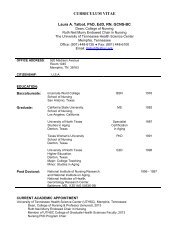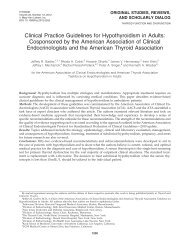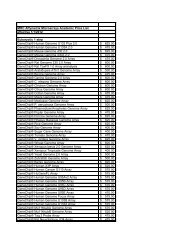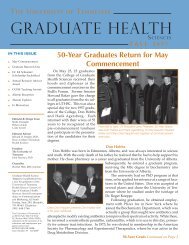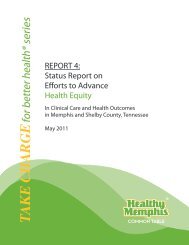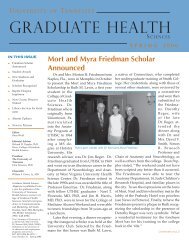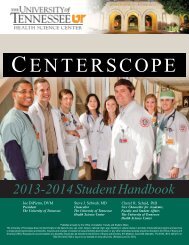Identification and Management of Hereditary Cancer Syndromes
Identification and Management of Hereditary Cancer Syndromes
Identification and Management of Hereditary Cancer Syndromes
- No tags were found...
You also want an ePaper? Increase the reach of your titles
YUMPU automatically turns print PDFs into web optimized ePapers that Google loves.
IDENTIFICATION ANDMANAGEMENT OFHEREDITARY CANCERSYNDROMESCarrie Horton, MS, CGCDirector <strong>of</strong> Genetic Counseling – The West Clinic
Objectives Review <strong>of</strong> clinical features <strong>and</strong> diagnostic criteria <strong>of</strong>hereditary cancer syndromes Update on national recommendations <strong>and</strong>/orconsensus guidelines for surveillance,chemoprevention, <strong>and</strong> surgical options Present psychosocial, ethical, <strong>and</strong> legal implicationsassociated with genetic testing
Genetic testing for high risk individuals Societal St<strong>and</strong>ards <strong>and</strong> Guidelines ACOG – America Congress <strong>of</strong> Obstetricians <strong>and</strong>Gynecologists AMA – American Medical Association ASCO – American Society <strong>of</strong> Clinical Oncologists NCCN – National Comprehensive <strong>Cancer</strong> Network SGO – Society <strong>of</strong> Gynecologic Oncologists SSO – Society <strong>of</strong> Surgical Oncology USPSTF – US Preventive Services Task Force ACCC - Association <strong>of</strong> Community <strong>Cancer</strong> Centers NSGC – National Society <strong>of</strong> Genetic Counselors ASBS – American Society <strong>of</strong> Breast Surgeons
<strong>Hereditary</strong> Breast <strong>Cancer</strong> <strong>Hereditary</strong> Breast Ovarian <strong>Cancer</strong> Syndrome Li Fraumeni Syndrome Cowden Syndrome Peutz Jegher (reviewed as GI syndrome) <strong>Hereditary</strong> Diffuse Gastric <strong>Cancer</strong> (reviewed as GIsyndrome)
<strong>Hereditary</strong> Breast Ovarian <strong>Cancer</strong>Syndrome (HBOC) Gene: BRCA1 <strong>and</strong> BRCA2 Carrier frequency: 1/500 to 1/1,000 Ashkenazi Jewish: 1/40<strong>Cancer</strong> site BRCA1 Lifetime risk % BRCA2 Lifetime risk %Breast 55-85% 55-85%Contralateral Breast 40-60% 40-60%Ovary 20-45% 10-20%Male Breast 1-2% 6-8%PancreaticProstate, Melanoma,GastricVariable depending onstudyVariable depending onstudy7%Variable depending onstudy
Diagnosis BRCA 1 <strong>and</strong> BRCA 2 germline genetic testing Patented gene BRCA sequencing Deletions/duplications/rearrangements (BART)• More prevalent in African American <strong>and</strong> Latinos• Most recent revision to NCCN guidelines recommend includingBART on all patients Personal <strong>and</strong> Family History Multiple generations <strong>of</strong> early onset breast cancer + ovariancancer Negative BRCA results Follow HBOC surveillance <strong>and</strong> surgery recommendations
Surveillance <strong>and</strong> Risk Reduction<strong>Cancer</strong> Site (lifetime risk) <strong>Management</strong> Age <strong>of</strong> InitiationBreast (55-85%)Ovarian (20-45%)Male Breast (6%)•Annual mammogram <strong>and</strong> breast MRI•Clinical Breast exam every 6 months•Discussion <strong>of</strong> prophylactic mastectomy•Chemoprevention (i.e. tamoxifen) forwomen electing breast conservation•Transvaginal ultrasound <strong>and</strong> CA-125levels every 6 months•Recommend BSO•Chemoprevention (i.e. OCP)•Clinical Breast exam every 6-12 months•Consider baseline mammogram25y25y30y35-40y35y40yPancreatic (7%)•No recommendations
Clinical Considerations Surgical decision making BRCA status can be valuable information for patientsconsidering lumpectomy vs mastectomy Beneficial to <strong>of</strong>fer genetic counseling/testing beforesurgery Chemotherapy/Clinical Trials PARP Inhibitors
Li Fraumeni syndrome p53 gene (also CHEK2) Autosomal dominant with up to 20% de novo Core cancers Sarcomas (s<strong>of</strong>t tissue <strong>and</strong> osteosarcomas) Breast cancer Hematologic malignancies Malignant brain tumors Adrenocortical carcinoma Widely variable expressivity with regards to cancer type –predominant feature is age <strong>of</strong> onset 50% <strong>of</strong> patients have first cancer before age 30, 90% by age 50 Nearly 100% lifetime risk for cancer in females, slightly lower formales
Diagnosis Personal <strong>and</strong> Family History Classic criteria Chompret criteria Birch criteria Eeles criteria p53 germline sequencing <strong>and</strong>del/dup/rearrangements Strongly suggest involvement <strong>of</strong> pre-test geneticcounseling
Clinical DescriptionClassic LFS Prob<strong>and</strong> diagnosed with sarcoma before 45 years <strong>of</strong> age, <strong>and</strong> A first-degree relative with cancer before 45 years <strong>of</strong> age, <strong>and</strong> Another first- or second-degree relative with any cancer diagnosedunder 45 years <strong>of</strong> age or with sarcoma at any ageChompret (Li Fraumeni-Like) Prob<strong>and</strong> with tumor belonging to LFS tumor spectrum (eg, s<strong>of</strong>t tissuesarcoma, osteosarcoma, brain tumor, premenopausal breast cancer,adrenocortical carcinoma, leukemia, lung bronchoalveolar cancer)before age 46 years AND at least one first- or second-degree relative with LFS tumor (exceptbreast cancer if prob<strong>and</strong> has breast cancer) before age 56 years orwith multiple tumors; OR Prob<strong>and</strong> with multiple tumors (except multiple breast tumors), two <strong>of</strong>which belong to LFS tumor spectrum <strong>and</strong> first <strong>of</strong> which occurred beforeage 46 years; OR Patient with adrenocortical carcinoma or choroid plexus carcinoma
Surveillance <strong>and</strong> Risk Reduction High risk breast surveillance protocol vs mastectomy Colonoscopy every 2-5 years starting no later than25y Otherwise, efficacy <strong>of</strong> surveillance is limited Annual physical with special attention to derm <strong>and</strong>neurologic findings Emerging data on annual rapid whole-body MRI• NIH study for Li Fraumeni families to evaluate novelscreening approaches involving age-specific biochemicalmarkers <strong>and</strong> imaging techniques
Clinical Considerations Susceptibility to radiation-induced sarcoma Pt with breast ca <strong>and</strong> p53 mutation - favor mastectomyover lumpectomy <strong>and</strong> radiation Consider as a differential for breast ca
Cowden syndrome PTEN gene PTEN Hamartoma Tumor Syndrome Major• Macrocephaly• Oral papillomas, trichilemmomas• Breast cancer• Non-medullary thyroid cancer• Uterine ca• Hamartomatous polyps Minor• Papillary renal ca• Thyroid goiter/nodules• Benign breast disease• Mental Retardation/Learning Disabilities• AVMs
Diagnosis Personal <strong>and</strong> Family History Features that warrant further testing:• Two major criteria• One major <strong>and</strong> two minor criteria• Three minor criteria involving different organ systems PTEN germline sequencing <strong>and</strong>del/dup/rearrangements Research testing at Clevel<strong>and</strong> Clinic Clinical testing
<strong>Cancer</strong> Risks <strong>and</strong> <strong>Management</strong><strong>Cancer</strong> Site (lifetime risk) <strong>Management</strong> Age <strong>of</strong> InitiationBreast (25-50%)Uterus (10%)Thyroid (10%)•Annual mammogram <strong>and</strong> breast MRI•Clinical Breast exam every 6 months•Discussion <strong>of</strong> prophylacticmastectomy•Annual pelvic exam <strong>and</strong> Pap•Review signs <strong>and</strong> symptoms <strong>of</strong> cancer•Discussion <strong>of</strong> prophylactichysterectomy•Baseline thyroid ultrasound•Consider annual thyroid ultrasound vsphysical examMucocutaneous –benign •Annual dermatologic exam(99%)Colon (9%) •Consider colonoscopy every 5-10years25y18y18y18y18+y10y35y
Breast Referral Guidelines – AffectedIndividualPatient with: Breast ca dx
Referral Guidelines – UnaffectedIndividual Ideal c<strong>and</strong>idate for testing are affected individuals Results are more informative Family history <strong>of</strong> 1 st or 2 nd degree relative with any<strong>of</strong> the criteria above
<strong>Hereditary</strong> GI <strong>Cancer</strong> <strong>Syndromes</strong> Lynch syndrome (HNPCC) Familial Adenomatous Polyposis MYH Associated Polyposis Overlap with breast cancer syndromes Peutz Jeghers <strong>Hereditary</strong> Diffuse Gastric <strong>Cancer</strong>
Lynch Syndrome• <strong>Hereditary</strong> NonPolyposis Colon <strong>Cancer</strong> (HNPCC)• 2-3% <strong>of</strong> all colorectal <strong>and</strong> endometrial cancerdiagnoses• Caused by mutations in one <strong>of</strong> multiple genes in themismatch repair familyo MLH1o MSH2o MSH6o PMS2o EpCAM (upstream <strong>of</strong> MSH2)
<strong>Cancer</strong> Risks<strong>Cancer</strong> Type General Population Lynch SyndromeColon 5-6% 80%2 nd colon within 10 years 30%Endometrial 2-3% 20-60% (gene specific)Stomach 1% 6-13%Ovarian 1-2% 9-12%Hepatobiliary 1% 2-7%Urinary tract
Diagnosis Amsterdam criteria Bethesda criteria MSI/IHC tumor testing Germline molecular genetic testing
Bethesda Guidelines Patients who meet Amsterdam Criteria Colorectal or uterine cancer diagnosed in a patient who isless than 50 years <strong>of</strong> age Presence <strong>of</strong> synchronous, metachronous colorectal, or otherHNPCC-associated tumors, regardless <strong>of</strong> age. Colorectal cancer with the MSI-H histology diagnosed in apatient who is less than 60 years <strong>of</strong> age. Colorectal cancer diagnosed in one or more first-degreerelatives with an HNPCC-related tumor, with one <strong>of</strong> thecancers being diagnosed under age 50 years. Colorectal cancer diagnosed in two or more first- or seconddegreerelatives with HNPCC-related tumors, regardless <strong>of</strong>age.Designed to determine who is a good c<strong>and</strong>idate for MSI/IHCtumor screening
Tumor Testing Microsatellite Instability (MSI) 15% <strong>of</strong> all colorectal tumors show MSI by PCR The majority are NOT Lynch syndrome related Immunohistochemistry (IHC) Staining <strong>of</strong> MLH1, MSH2, MSH6, <strong>and</strong> PMS2 proteins MLH1/PMS2 dimerize – absent together• 80% <strong>of</strong> MLH1 absense is due to methylation, most <strong>of</strong>tenbecause <strong>of</strong> somatic mutation in BRAF MSH2/MSH6 dimerize – absent together
Tumor testing pros <strong>and</strong> cons Compared to direct germline sequencing Pros: Cost effective• Eliminates unnecessary testing for low risk individuals• Allows for targeted germline testing Universal screening increases pick up Consistent with NCCN guidelines Cons: Slower TAT for results Logistically more to arrange Possibility <strong>of</strong> false negative (especially in lesions other thancolon ca <strong>and</strong> endometrial ca)
Colorectal orEndometrial TumorIHC (hMLH1, hMSH2, hMSH6, hPMS2)Normal IHCAbsent MLH1+/- PMS2Absent MSH2, MSH6, or PMS2Equivocal IHCNo further testingReflex to BRAFMutation testingMutation detectedNo further testingNo mutation detectedConsider referral forgenetic counselingTargeted germline testing<strong>of</strong> defective MMR gene
Call your friendly neighborhoodgenetic counselor• MLH/West Clinic genetic counselors• Carrie Horton: 901-683-0055 x1322• Morgan Depas 901-683-0055 x8029• Baptist/Boston Baskin genetic counselors• Regina Nuccio 901-226-4064• Lorrell White 901-226-4038• Genetic counselors available on call at manygenetic testing laboratorieso Ambry Genetics <strong>and</strong> Myriad Genetics
<strong>Management</strong><strong>Cancer</strong> Site (lifetime risk) <strong>Management</strong> Age <strong>of</strong> InitiationColon (80%)Uterus (20-60%) <strong>and</strong>Ovarian (12%)Gastric (20%) <strong>and</strong> SmallBowel (4%)•Colonoscopy every 1-2 years•Consideration <strong>of</strong> colectomy with IRAbased on polyp burden•Annual pelvic exam <strong>and</strong> Pap•TAH/BSO•TVUS, Endometrial sampling, CA125•Extended EGD every 2-3 years•Consider capsule20-25 yearsPossibly later for MSH6 <strong>and</strong>PMS2?•18y•35y or after childbearing30-35y30-35yUrothelial (5%) •Consider annual urinalysis 25-30yCNS (3%) •Annual physical exam 25-30yPancreatic (7%)•No current recommendations
Clinical Considerations Endometrial cancer can be the first diagnosis inLynch pts 50% <strong>of</strong> women present with endometrial first <strong>and</strong> thendevelop a potentially avoidable colon ca When available, tumor screening is a cost effective<strong>and</strong> informative method <strong>of</strong> identifying pts
Familial Adenomatous PolyposisAPC geneClinical Description Classic FAP• >100 to 1000s <strong>of</strong> polyps• Onset in adolescence• Near 100% lifetime risk for colon cancer• Average age <strong>of</strong> colon ca dx 39y Attenuated FAP•
Genotype Phenotype Correlation• Location <strong>of</strong> gene mutation can predictphenotype• Number <strong>of</strong> adenomas, average age <strong>of</strong>colon cancer, extracolonic features
<strong>Management</strong><strong>Management</strong> option Classic FAP Attenuated FAPColon SurveillanceSurgeryGastric/DuodenumThyroid, CNSDesmoidsHepatoblastomaEvery year beginning age10-12yProctocolectomy with IPAAat onset <strong>of</strong> polyps•Evaluate pouch for polypsBaseline extended EGDwith side-viewing exam byage 20-25, intervalfrequency determined bypolyp burdenAnnual physical exambeginning late teensAbdominal ultrasound <strong>and</strong>AFP every 3-6 months untilage 5yEvery year beginning age18-20yConsider colectomy withIRA•Evaluate rectum for polyps*same as classic*same as classic*same as classic
MYH Associated Polyposis MutYH Adenomatous polyposis Autosomal recessive Family history absent or confined to sibship Questionable haploinsufficiency – breakthroughphenotype for “carriers” Follow Attenuated FAP recommendations for colon<strong>and</strong> duodenum, low risk for non-GI findings
Clinical Considerations In practice, clinical diagnosis <strong>of</strong> FAP is <strong>of</strong>ten notconfirmed with genetic testing Genetic test results can influence surgical options Informative for the family• Duty to warn lawsuits• Identify low risk individuals A de novo case <strong>of</strong> FAP is clinically indistinguishablefrom MYH polyposis but has different implications forsurveillance <strong>and</strong> inheritance Even in apparently de novo cases, test siblings
Peutz Jeghers syndrome STK11 gene Typically presents as small bowelpolyposis Hamartomas Breast <strong>Cancer</strong> Colon, small bowel, pancreaticcancer GYN, testicular <strong>and</strong> sex cord tumors Mucocutaneous freckling
<strong>Cancer</strong> Risks <strong>and</strong> <strong>Management</strong><strong>Cancer</strong> Site (lifetime risk) <strong>Management</strong> Age <strong>of</strong> InitiationBreast (40-50%)•Annual mammogram <strong>and</strong> breast MRI•Clinical Breast exam every 6 months•Discussion <strong>of</strong> prophylactic mastectomy25y18yColon (40%) •Colonoscopy every 2-3 years 18yStomach (30%) •Upper endoscopy ever 2-3 years 18yPancreas (11-35%) •MR cholangiopancreatography <strong>and</strong>/orendoscopic ultrasound every 1-2 years•CA 19-9 every 1-2 years25-30ySmall bowel (13%)Ovary (20%), cervix(10%), uterus (9%)TestesLung (15%)•CT enterography/small bowel enteroclysisbaseline•CT enterography/small bowel enteroclysisevery 2-3 years•Annual Pelvic exam <strong>and</strong> Pap•Consider TV US•Annual testicular exam <strong>and</strong> observation forfeminization•Smoking cessation counseling8-10y18y18y10y
<strong>Hereditary</strong> Diffuse Gastric <strong>Cancer</strong>Syndrome (HDGC) CDH1 gene (e-cadherin) Genetic pathway directly informs the phenotype Gastric <strong>Cancer</strong> – diffuse (signet ring cell) type Breast <strong>Cancer</strong> – lobular only
Clinical Considerations Detection <strong>of</strong> diffuse gastric cancer is challenging 74% <strong>of</strong> HDGC pts who undergo “prophylactic”gastrectomy have an occult gastric cancer Number <strong>of</strong> endoscopic biopsies necessary to have 90%sensitivity? Gastrectomy is strongly favored 1% mortality in young healthy individuals 100% morbidity
<strong>Cancer</strong> Risks <strong>and</strong> <strong>Management</strong><strong>Cancer</strong> site (lifetime risk) <strong>Management</strong> Age <strong>of</strong> InitiationGastric (60-80%)Breast (40-50%)•Annual endoscopy withminimum <strong>of</strong> 30 biopsies•Total gastrectomy•Annual mammogram <strong>and</strong>breast MRI•16-18y•20y•35yColon (?) •Colonoscopy every 3-5 years •40y
GI Referral GuidelinesColon cancer diagnosed under 60y NCCN endorses universal tumor screening with IHC/MSI tumor screeningregardless <strong>of</strong> age or family hx Endometrial cancer 2 “Peutz Jegher” type hamartomas >3 Juvenile type polyps Diffuse gastric ca 50y + additional relatives with gastric ca
Other syndromes Multiple Endocrine Neoplasia Type 1 Multiple Endocrine Neoplasia Type 2 <strong>Hereditary</strong> Kidney <strong>Cancer</strong> Von Hippel Lindau <strong>Hereditary</strong> Leiomyomatosis <strong>and</strong> Renal Cell Carcinoma <strong>Hereditary</strong> Papillary Carcinoma Familial Paraganglioma/Pheo syndrome <strong>Hereditary</strong> Melanoma <strong>and</strong> Pancreatic <strong>Cancer</strong> Childhood cancer syndromes
Other genetic counseling issues Topics beyond than syndrome identification Family dynamics Unexpected results Patient reaction to results Ethical <strong>and</strong> legal considerations
Family Matters In hereditary syndromes, there is more than onepatient Results can allow for early detection <strong>and</strong> evenprevention <strong>of</strong> cancers in at-risk relatives Evaluate our duty to warn, especially when it is at oddswith the patient’s wishes Genetic testing for minors is performed on a caseby case basis Not typically advised for adult onset conditions
Family history is tricky “No family history <strong>of</strong> cancer” Early age <strong>of</strong> onset <strong>of</strong> initial patient – many other familymembers are also young <strong>and</strong> have not developed cancerYET Evolution <strong>of</strong> family history – new diagnoses occur <strong>and</strong> newinformation is disclosed Risk reducing surgery – breast cancer unaffected femaless/p bilateral oophorectomy Truncated history – paucity <strong>of</strong> females, adoption, onlychildren, early death De novo mutations – prob<strong>and</strong> is the first person with thedeleterious mutation Accuracy <strong>of</strong> patient report
“Unexpected” results Negative/normal genetic test results in a highlysuspicious family Testing <strong>of</strong> other family members <strong>Management</strong>? Variants Favor Polymorphism Suspected Deleterious Uncertain Significance
Patient Reaction to Results <strong>Cancer</strong> genetic counseling is unique <strong>Cancer</strong> is common generations <strong>of</strong> health beliefs How do genetic results fit into the picture? Special attention to results disclosure Some patients are devastated to find out they have amutation• Guilt for family members• Overwhelming to have additional cancer risks <strong>and</strong> decisions Some patients WANT to have a mutation• Pattern <strong>of</strong> cancer in the family is reality – result is an explanation<strong>and</strong> an opportunity for prevention• Isolation or guilt if negative in a mutation positive family
Psychosocial Impact Common emotions in high risk families Anger Anxiety Shame Fear <strong>of</strong> becoming a burden Loss <strong>of</strong> control Fear <strong>of</strong> disfigurement Negative body image Isolation Guilt
Informed ConsentCore elements <strong>of</strong> informed consent with regards to cancer genetictesting: Elicitation <strong>and</strong> discussion <strong>of</strong> a person’s expectations, beliefs, goals, <strong>and</strong>motivations. Explanation <strong>of</strong> how inheritance <strong>of</strong> genetic factors may affect cancersusceptibility. Clarification <strong>of</strong> a person’s increased risk status. Impact on at-risk relatives Potential benefits, risks, <strong>and</strong> limitations <strong>of</strong> testing technology <strong>and</strong> results. Costs <strong>and</strong> logistics <strong>of</strong> testing <strong>and</strong> follow-up. Benefits, limitations, <strong>and</strong> efficacy <strong>of</strong> medical management options. Possible psychological, social, economic, <strong>and</strong> family dynamicramifications <strong>of</strong> testing or not testing. Alternatives to genetic testing (e.g., tissue banking, risk assessmentwithout genetic testing).
Genetic Discrimination Federal <strong>and</strong> State Laws prohibit genetic discrimination HIPAA Genetic Information Nondiscrimination Act (GINA)• Positive results from predisposition testing cannot be a pre-existingcondition• Not used to change premiums or eligibility Over half a million clinical tests ordered – not onedocumented case <strong>of</strong> genetic discrimination Myth or reality? Theoretical possibility
Summary Genetic risk assessment for hereditary cancer isintegral in the comprehensive care <strong>of</strong> today’spatient Genetic test results influence current cancertreatment as well as long term surveillance Genetic testing is one part <strong>of</strong> the genetic counselingprocess
References <strong>and</strong> Resources Over 250 citations <strong>and</strong> references for this presentation chorton@westclinic.com 901-683-0055 x1322 Gene Tests – collaborative reviews on many <strong>of</strong> thesyndromes described genetests.org NCCN Clinical Practice Guidelines in Oncology Genetic/Familial High-Risk Assessment: Breast <strong>and</strong> Ovarian Colorectal <strong>Cancer</strong> Screening





